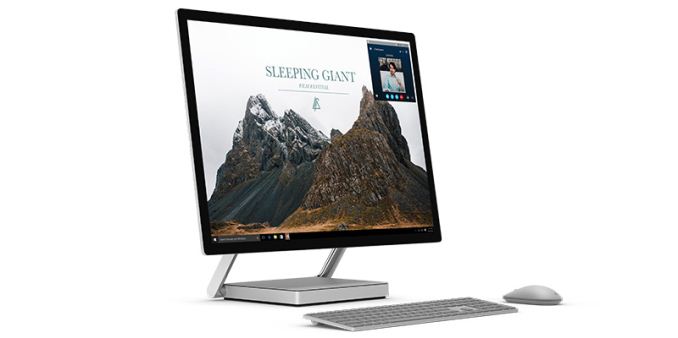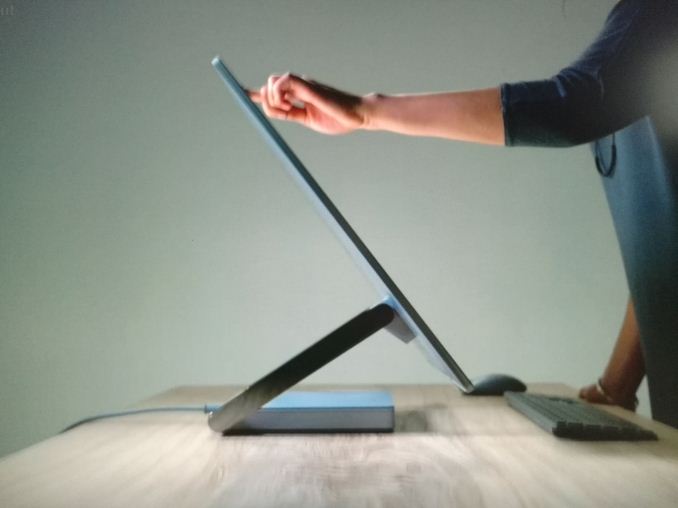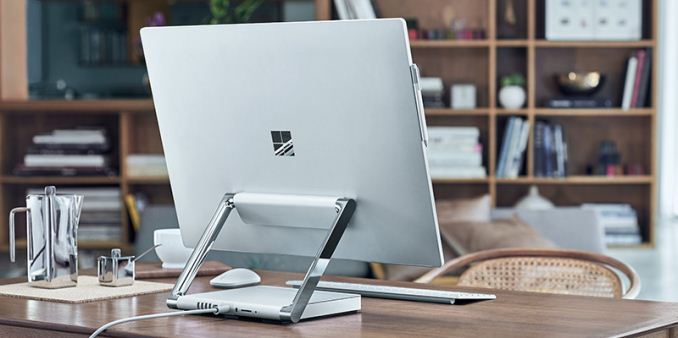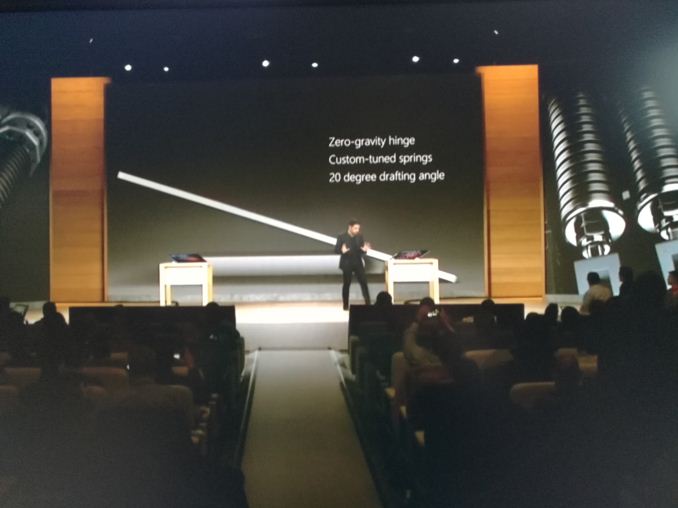Microsoft Announces the Surface Studio: 28-inch AIO with Touch, Pen, 4500x3000, Skylake, GTX 980M
by Ian Cutress on October 26, 2016 12:34 PM EST- Posted in
- Microsoft
- Systems
- Intel
- AIO
- all-in-one
- Surface
- Surface Studio

As part of the now annual Microsoft Surface event, Panos Panay announced the next member of the Surface family, the Surface Studio. The Studio is ultimately a prosumer all-in-one device promising more functionality and versatility than any other desktop all-in-one PC by allowing the device to also turn a desk into a studio.
Front and center in what makes the Studio impressive is the size of the display: a 28-inch thin-bezel LCD display with a 3:2 aspect ratio, coming in at a 4500x3000 resolution and 192 pixels per inch. By contrast to 4K, this is 13.5 million pixels compared to 8.3 million in UHD, and Microsoft is promoting True Scale with the studio such that two A4 pieces of paper can be rendered side by side at full resolution and at a higher DPI than most standard office printers. The display is 12.5mm thin, with Microsoft redesigning the LCD stack to ensure a slim profile.
The display connects to the base via a specialist hinge, featuring 80 machined parts on each side for what Microsoft calls a ‘Zero Gravity Hinge’. This allows the display to be moved seamlessly and for any plausible angle, as well as taking on extra weight in studio mode. The display has two buttons on the right-hand side for power and volume. On the top of the display is the Windows Hello-enabled camera, with a 5.0 MP element capable of 1080p video (we assume 30 FPS). The Studio supports the Surface Pen, which can attach to the side of the display.
For color reproduction, Microsoft is advertising the display as supporting both DCI-P3 and sRGB with a simple toggle on the Windows sidebar to switch between the two. While Microsoft says that the displays are calibrated for both, this has fundamental issues with color reproduction.
In the base is a set of arguably last-generation specifications: 6th generation (Skylake) Intel Core i5 and Core i7 processor options (probably 65W desktop parts?) paired with up to 32GB of DDR4 memory (probably DDR4-2133). This comes with a NVIDIA GTX 965M 2GB for two of the three options, and a GTX 980M 4GB on the high-end model. Connectivity comes via USB 3.0, rather than USB 3.1/Thunderbolt. Storage is labeled as ‘1TB or 2TB Rapid Hybrid Drive’ options, which in the presentation looked like an M.2 drive but as yet it has been unstated if this is SATA or PCIe (or if a Rapid Hybrid Drive actually means an SSHD).
| Microsoft Surface Studio | |||
| CPU | Intel Core i5 Skylake |
Intel Core i7 Skylake |
Intel Core i7 Skylake |
| GPU | NVIDIA GTX 965M 2GB |
NVIDIA GTX 980M 4GB |
|
| DRAM | 8GB DDR4 | 16 GB DDR4 | 32GB DDR4 |
| Storage | 1TB | 1TB | 2TB |
| 'Rapid Storage Drive' (SATA? PCIe? SSHD?) | |||
| Display | 28-inch 4500x3000 LCD Display 12.5mm thin 10-point MultiTouch Magnetic Pen Support |
||
| Connectivity | 802.11ac WiFi (Intel AC 8260?) Gigabit Ethernet Xbox Wireless |
||
| IO | 4 x USB 3.0 Full-Size SD card reader (SDXC) Mini DisplayPort 3.5mm Headset |
||
| Camera | 5MP Front Facing Windows Hello 1080p Recording |
||
| OS | Windows 10 Pro 30-day Office Trial |
||
| Dimensions | Display: 637.35 x 438.90 x 12.50 mm | ||
| Base: 250.00 x 200.00 x 32.2 mm | |||
| Weight: 9.56 kg / 21 lbs | |||
| Price | $2999 | $3499 | $4199 |
Connectivity comes via four USB 3.0 ports, a full-size SD card reader, a mini DisplayPort output and a 3.5mm headset jack. WiFi is provided by an 802.11ac unit, although Microsoft does not say which one (I’d hazard a guess and say Intel’s AC8260 2x2 solution). The unit also supports Xbox Wireless, allowing for Xbox controllers to also be connected for gaming.
The whole unit weighs in at 21 lbs (9.5 kg), and Microsoft has stated that it will be available only in limited quantities during Q4, with the official release date as 15th December. Current configurations available will be:
$2999 : Intel Core i5 (Skylake), 8 GB DDR4, 1TB, GTX 965M 2GB
$3499 : Intel Core i7 (Skylake), 16 GB DDR4, 1TB, GTX 965M 2GB
$4199 : Intel Core i7 (Skylake), 32 GB DDR4, 2TB, GTX 980M 4GB
Windows 10 Pro is included with a 30-day Office trial.
Edit: Originally this piece was posted with the incorrect Intel Generation code name in the title. It should read 'Skylake', not 'Haswell'. The piece has been edited to clarify.
Source: Microsoft





















82 Comments
View All Comments
jsntech - Wednesday, October 26, 2016 - link
I would never pay that for an AIO, but holy monkey is that 3:2 display delightful. Please let that catch on elsewhere!Drumsticks - Wednesday, October 26, 2016 - link
It's expensive as an AIO, but the kicker is the pen support on a 28" display of that caliber. Compare it to the 27" Cintiq 27QHD with a 2560x1440 resolution display, for $2799, and an AIO for an extra $200-$1400 isn't so bad.GatesDA - Friday, October 28, 2016 - link
The base Studio config is actually $200 cheaper if you factor in the Cintiq's $400 stand.theuglyman0war - Sunday, March 12, 2017 - link
Agree.. If I could upgrade the GPU I would had bought it :(iwod - Thursday, October 27, 2016 - link
Holy yes, finally some will know that 95% of the time people dont use their PC to watch 16:9 movies.16:10 would be fine by me, but 3:2 is even better.
pzkfwg - Wednesday, October 26, 2016 - link
Isn't Haswell the 4th generation?...Ian Cutress - Wednesday, October 26, 2016 - link
Yup, somehow I can't remember Intel Gen names that well after two hours of press event. Updated to say Skylake.mac_savant - Wednesday, October 26, 2016 - link
I thought Haswell was 4th generation and 6th generation was Skylake. Oh well...MonkeyPaw - Wednesday, October 26, 2016 - link
It can't be Haswell unless it's Haswell-E. These come with DDR4.Ro_Ja - Tuesday, November 1, 2016 - link
Haswell is still considered 5th gen though even if it came with an E. Broadwell-E is considered 6th gen since it's in a Intel Core 6000 series family.